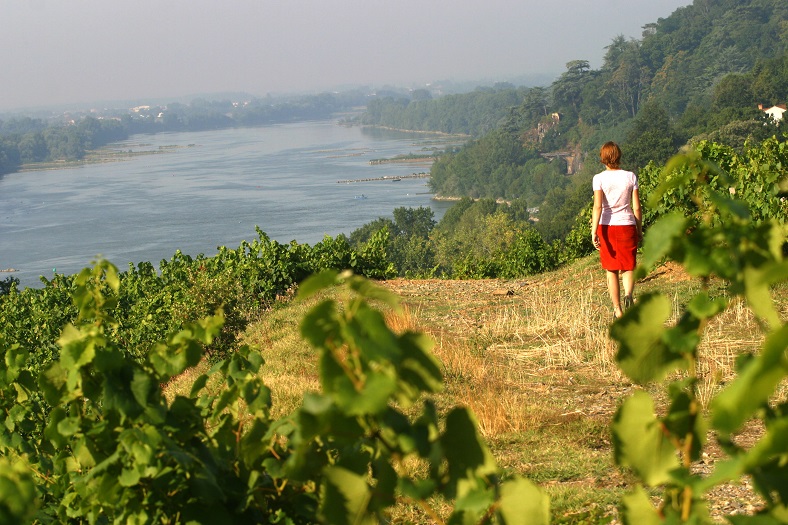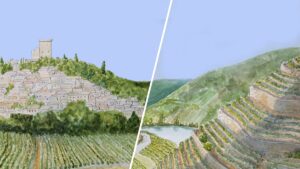
Long restricted to the rank of a simple seaside accompaniment, Muscadet is more than just a wine to pair with a platter of oysters. A sub-region of the western Loire Valley, it tends to be overshadowed by the established success of its neighbours. However, a breath of fresh air has swept into the appellation with a new generation of vintners, some of whom have drastically altered crafting methods in an attempt to renew Muscadet’s image. The area and its produce are undergoing an important transformation…
The Muscadet appellation at a glance
The 9,000 hectares of land that make up Muscadet were initially planted with vines by the Romans, before the monks of the Middle Ages took up the task several centuries later. Muscadet is also one of the oldest appellations, recognised in 1937, and is the Loire’s biggest producer in volume.
To be even more precise, there are also sub-regional appellations that feature in this understated wine spot, and these are:
- Muscadet-Sèvre-et-Maine: the largest of the three with over 6,000 hectares of vines planted between the two eponymous rivers.
- Muscadet-Côtes-de-Grandlieu: modest in size, this appellation is named after a local lake.
- Muscadet-Coteaux-de-la-Loire: located between Nantes and Ancenis, this is the smallest of the three in terms of surface area.
To this, we can add a system of cru labels, established in 2011 to recognise notable terroirs: Clisson, Gorges, and Le Pallet, which were quickly joined by Goulaine, La Haye-Fouassière, Champtoceaux, Vallet, Monnières Saint-Fiacre, Château-Thébaud, and Mouzillon-Tillières.
Grape varieties
Melon de Bourgogne, a.k.a Muscadet
Being located towards the north, this sub-region is a perfect home for white grapes, 99% of which are…you guessed it…the Muscadet variety, also known as Melon de Bourgogne. Distantly related to Chardonnay, it makes dry, firm whites that live up to their expectation as a good pairing for seafood dishes. This is a good example of a cliché with substance, since the region’s maritime location only makes sense for such a match. Though we are seeing more and more that Muscadet’s potential extends way beyond this seaside stereotype.
Folle Blanche, Gamay and Chardonnay
Much smaller in quantity but not unimportant are the Folle Blanche grapes used to make Gros-Plant-du-Pays-Nantais wines. These have been joined very recently by Chardonnay. And when it comes to red wines, Gamay create pleasantly light and delicate wines in this appellation.
Muscadet’s renaissance
This gem of an appellation hasn’t been short of detractors. The idea that its wines have little personality and excess acidity has been a difficult image to shake. Plus, it was down to the négoces to fix volume demand. In short, the regions surrounding Muscadet have always been a step (or a few) ahead when it comes to renown.
Vintners were tired of this, and they’d had enough of a system that forced them to have their wines bottled and sold before the 30th November following the harvest. Le Gorgeois was created, an association that created a serious set of official criteria at the end of the 1990s. Included were such propositions as harvesting by hand, restricting yields for higher-quality fruit, and longer maturation periods to move away from the much-criticised acidity levels. These shifts brought about the cru system as well the acceptance of a new grape: Chardonnay.
Maturing well
You might have already heard about maturation on lees. Not only is this a popular practice in Muscadet, but some even say that it was invented there!
Today, it tends to be applied to wines that mature for 18 to 24 months. Lees are the dead yeasts that set off the process of alcoholic fermentation right at the beginning of vinification, by turning fruit sugar into alcohol. When a wine matures ‘on lees’, it means that these dead yeasts are kept in contact with the resulting wine. As they decompose, they give the wine a rounder character, livening it with deeper aromas and giving it good ageing potential.
What are Muscadet wines like?
Generally speaking, the profile of a Muscadet wine is delicate with subtle aromas that lean towards floral, citrus, and salty notes. Lee maturation confers a certain sparkling element to the wine balanced by a generous palate. Quite sharp in character, Muscadet can be enjoyed in its youth with delicate dishes like fish and other kinds of seafood. If you want to move away from the beaten track, try a heavier dish like rillettes or any kind of terrine; the fat will be beautifully balanced out by the wine’s liveliness. The cuvées that come with a cru label can likely be aged for around a decade. Their rich aromas will pair with characterful dishes like poultry in a creamy mushroom sauce, a sumptuous risotto or creamy goats cheese (even better when it comes from the region).
Winemakers to watch
There are certain flagship domains that have led the Muscadet revival, and these ones deserve a special mention. Those that are our partner producers are:
Domaine de l’Ecu: An emblematic signature that cultivates its vines organically and biodynamically on fine terroirs.
Domaine de Bellevue: Jérôme Bretaudeau runs this estate with his distinctive extravagance, passionate as he is about his grape varieties and crafting techniques alike.
Jo Landron: A vintner who has worked determinedly to bring his wine region into the spotlight. Biodynamic methods, single-parcel vinification…ageing wines that match texture with minerality.
Luneau-Papin: The star of the single-plot craft, vinifying Melon de Bourgogne in all of its guises via a dozen cuvées of formidable precision.
Bonnet-Huteau: A family estate of 41 hectares that received organic certification in 2005 and has exited for more than 150 years.



